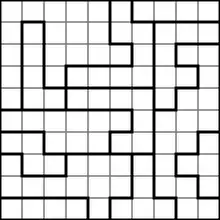
LITS, formerly known as Nuruomino (ヌルオミノ), is a binary determination puzzle published by Nikoli.
Rules
LITS is played on a rectangular grid, typically 10×10; the grid is divided into polyominoes, none of which have fewer than four cells. The goal is to shade in a tetromino within each pre-printed polyomino in such a way that no two matching tetrominoes are orthogonally adjacent (with rotations and reflections counting as matching), and that the shaded cells form a valid nurikabe: they are all orthogonally contiguous (form a single polyomino) and contain no 2×2 square tetrominoes as subsets.
History
The puzzle was first printed in Puzzle Communication Nikoli #106; the original title is a combination of 'nuru' (Japanese: "to paint") and 'omino' (polyomino). In issue #112, the title was changed to the present one, which represents the four (of five) tetrominoes used in the puzzle: the L-shape, the straight, the T-shape, and the skew (square tetrominoes may never appear in the puzzle as they are a direct violation of the rule).
Solving Strategies
There are some simple, and difficult, strategies for this puzzle.
Instant solutions and chains
There are 4 different "instantly solvable" cases, the L, S, T, and I can all be instantly solved in boxes that only have 4 blocks.
There are also "chains" or 4 blocks eliminating a block from a 5 block box, creating another location for the next tetromino.
Inherent locational placements
If you see 5 pieces, you will always be able to place at least one block inside of the pentomino(like tetromino, but for 5). Like if you see a t with an extra block on the top, the two spots in the middle can be filled in, since every possible tetromino takes place in those 2 blocks. Every other location can be inherently assumed based on the amount of possible tetrominoes, and the overlapping tiles of all of them.